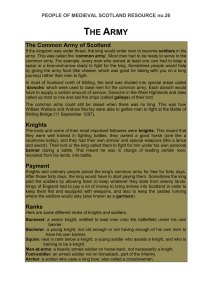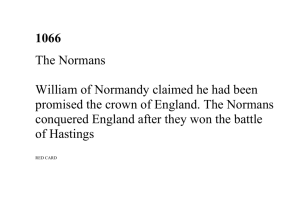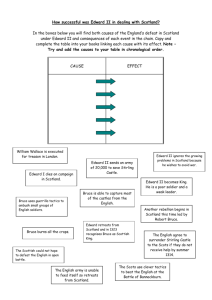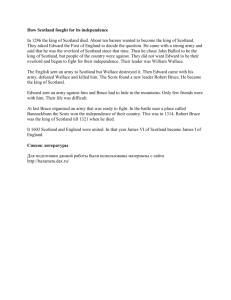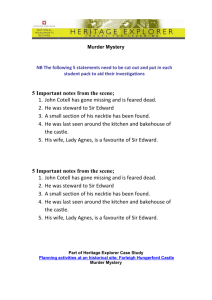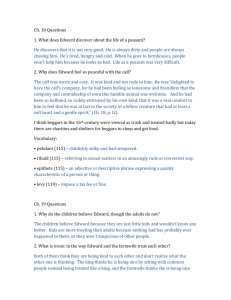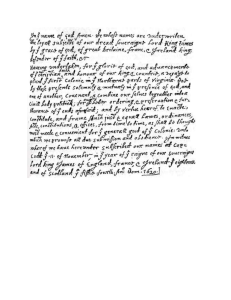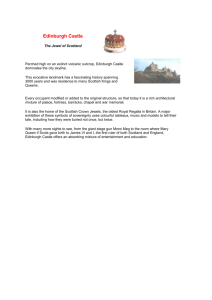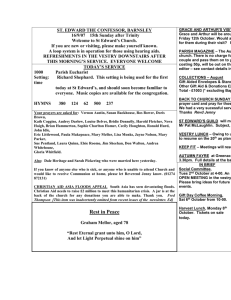Word file: 26. The Army
advertisement
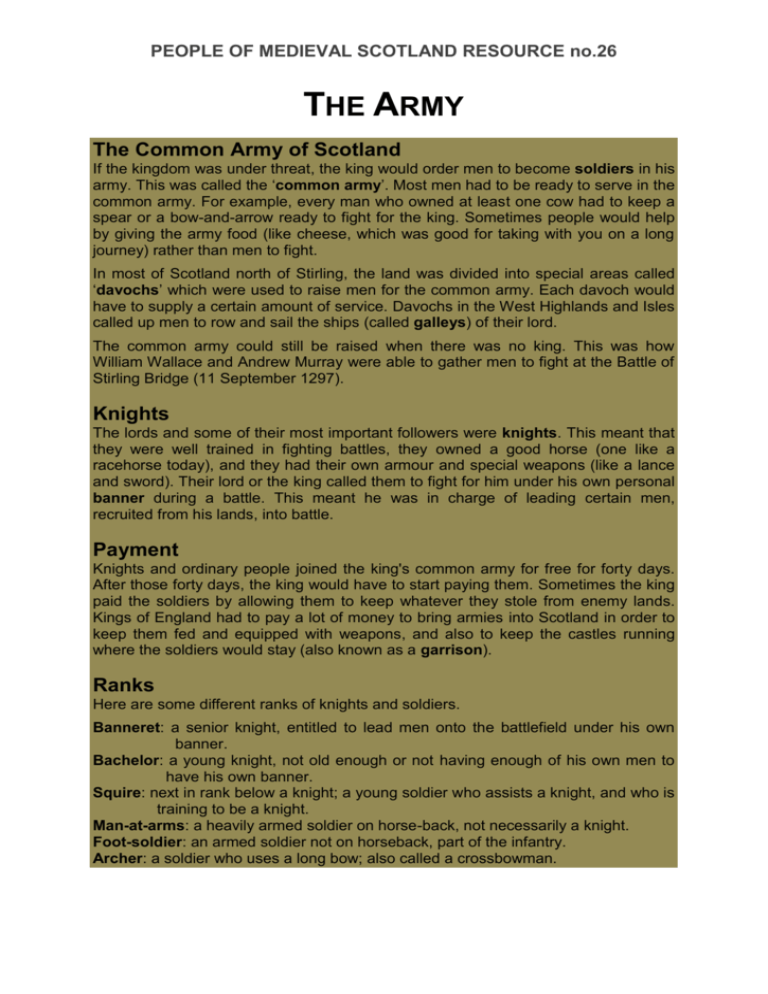
PEOPLE OF MEDIEVAL SCOTLAND RESOURCE no.26 THE ARMY The Common Army of Scotland If the kingdom was under threat, the king would order men to become soldiers in his army. This was called the ‘common army’. Most men had to be ready to serve in the common army. For example, every man who owned at least one cow had to keep a spear or a bow-and-arrow ready to fight for the king. Sometimes people would help by giving the army food (like cheese, which was good for taking with you on a long journey) rather than men to fight. In most of Scotland north of Stirling, the land was divided into special areas called ‘davochs’ which were used to raise men for the common army. Each davoch would have to supply a certain amount of service. Davochs in the West Highlands and Isles called up men to row and sail the ships (called galleys) of their lord. The common army could still be raised when there was no king. This was how William Wallace and Andrew Murray were able to gather men to fight at the Battle of Stirling Bridge (11 September 1297). Knights The lords and some of their most important followers were knights. This meant that they were well trained in fighting battles, they owned a good horse (one like a racehorse today), and they had their own armour and special weapons (like a lance and sword). Their lord or the king called them to fight for him under his own personal banner during a battle. This meant he was in charge of leading certain men, recruited from his lands, into battle. Payment Knights and ordinary people joined the king's common army for free for forty days. After those forty days, the king would have to start paying them. Sometimes the king paid the soldiers by allowing them to keep whatever they stole from enemy lands. Kings of England had to pay a lot of money to bring armies into Scotland in order to keep them fed and equipped with weapons, and also to keep the castles running where the soldiers would stay (also known as a garrison). Ranks Here are some different ranks of knights and soldiers. Banneret: a senior knight, entitled to lead men onto the battlefield under his own banner. Bachelor: a young knight, not old enough or not having enough of his own men to have his own banner. Squire: next in rank below a knight; a young soldier who assists a knight, and who is training to be a knight. Man-at-arms: a heavily armed soldier on horse-back, not necessarily a knight. Foot-soldier: an armed soldier not on horseback, part of the infantry. Archer: a soldier who uses a long bow; also called a crossbowman. THE ENGLISH ARMY 23 October 1297 King Edward orders one of his men to assemble an army. King Edward to William of Ormsby: greeting. I command you to raise an army of footsoldiers to suppress the insurrection in Scotland. 1298 King Edward assigns more soldiers to Berwick Castle. King Edward and his council announce that Berwick should have 60 men-at-arms and 1000 foot-soldiers, of which 100 should be crossbowmen. These soldiers should receive the king’s wages in the same way in which the sheriff of Roxburgh, the sheriff of Jedburgh and Sir Simon Fraser receive theirs. 19 November 1298 Edward appoints Patrick of Dunbar (an earl in the Scottish borders) to be chief of his army, castles and garrisons in southern Scotland. I Edward, king of England, lord of Ireland and duke of Aquitaine, announce that I have appointed my loyal man, Patrick earl of Dunbar, to be chief of my troops, my castles and other places which are garrisoned on the borders and elsewhere on this side of the Scottish sea [south of the River Forth]. 27 June 1300 King Edward writes to his officials telling them to raise more men to be soldiers in his army. King Edward to his treasurer and chancellor: greeting. My affairs in Scotland are much held back by lack of good foot-soldiers. You should choose from the counties nearest the border of Scotland 10,000 foot-soldiers, in addition to the number already serving with me, and have them brought to Carlisle. Dumfries: 15 July 1300 King Edward tells his official that certain foot-soldiers should be imprisoned for leaving his army without permission. He is frustrated by the poor performance of his sheriffs and by the foot-soldiers leaving. King Edward to the keeper of my personal spending accounts: greeting. I send you, under my seal, the names of foot-soldiers of Yorkshire who have departed from my service without leave, wickedly and treacherously deceiving me. I order that you and my treasurer announce that these men, whatever their status, should be taken and safely held in prison and their lands confiscated without delay. And they should not be released without my special command. Because I have heard that my sheriffs and their officials do not always carry out my tasks very well, I order you to assign this task not to them but to trusty men who will give it all of their attention, so that the men remaining in my army may take example from the punishment of these men who served me so ill. 2 Between May and October 1301 Record of payment to a monk for leading men in the king’s army. Payment made to William Grentham, a monk of Durham Cathedral, for following King Edward in the war with St Cuthbert’s banner. Between May and October 1301 Record of payment to a surgeon. Payment made to master Roger Causcy, surgeon, for healing foot-soldiers in the garrison of Stirling who were recently wounded when fighting for King Edward. Berwick: 14 September 1301 The keeper of Berwick castle tells Edward I of a mutiny which occurred in his castle by foot-soldiers who had not been paid. When he finally received money to pay them, a knight called Sir Walter took more money than he was due. The keeper of Berwick Castle to my lord king Edward: greeting. As the £200 which I ordered did not reach me until 28 August, a mutiny arose among the foot-soldiers and archers in the garrison of Berwick, joined by some of the men-at-arms of Sir Ralph, who is their leader in all riots. Though they swore that if any man-at-arms approached the castle walls they would kill his horse and cut off his head, I armed and mounted my people and rode up the great street, which they were blocking. When they saw me, they let me pass, but they returned and molested my people vilely. I placed two men-at-arms at each post of the castle. When I consulted the knight Sir Walter de Teye, he said that he could not blame the mutineers, for when the earls of England were in town, they had only received 3 days’ pay and were now overdue a month’s pay. So my people and I remained on guard at the castle walls all night, and before sunrise Sir John de Seyton came with 4 valets to my aid. 11 October 1301 Edward sends for more money from London as he cannot pay his soldiers. Edward I to his treasurer: greetings. I am greatly surprised that you have sent me so little money. I have been unable to pay my troops because of this. I strongly charge you to send all the money you can as soon as possible. Because my son, the prince, is joining me, any money for him, his wife and their company should be sent directly to me, not to Carlisle. You should also supply the garrisons of Dumfries and Lochmaben according to previous arrangements. 16 October 1301 Edward sends for more money from London as he will be staying in Scotland over winter and would like to build a bridge over the River Forth. Edward I to his treasurer: greetings. I complain that I am still seriously short of money. If it were not for this lack of money I would have completed the bridge across the Firth of Forth. I therefore order you to send as much money as possible, since I intend to spend the winter in 3 Scotland. Any money sent into Scotland is to be sent to me only, with the following exceptions: money sent to Galloway for the garrisons of Dumfries and Lochmaben, and money sent to Earl Patrick who is at Ayr. When the queen and prince of Wales join me, money for them is to be sent straight to me. 6 May 1304 Record of a payment made to a soldier for losing his horse. Payment made to Henry de Bentley, a soldier in the garrison of Kirkintilloch, 4 marks [about £1,400 today] for the replacement of his horse lost while in the king’s service. London: 20 December 1309 The English government decides that a knight named Robert de Clifford should be the new warden of Scotland (who was in charge of all the affairs there on behalf of the king). Robert is to have 100 men-at-arms (soldiers on horses) and 300 foot-soldiers and control of the garrisons in castles. It was declared at London on 20 December that Sir Robert de Clifford should be the warden of Scotland, with a force of 100 men-at-arms and 300 foot-soldiers, plus the garrisons of castles, until Easter next. 60 of the men-at-arms should be from Robert’s own retinue, and 40 from the household under Sir Robert of Felton at the king’s pay. 11 November 1310 More men are sent to Perth castle to help protect it from Robert the Bruce’s forces. Decision that Sir Roger de Mowbray, with 20 men-at-arms of his own retinue, shall join Sir Henry de Beaumont and others in garrison at Perth, in order to aid them in keeping Perth and the country beyond the River Forth safe until next Easter. Roger should take for himself and his 20 men 300 marks [about £90,000 today] for their wages, horses, and all other costs. February 1311 Records of payments made to English boatmen serving the king. Payment made to John de Yokflet for the wages of 100 boatmen assigned to guard the River Forth on both sides between Berwick and Stirling. Payment made to Richard Councedieu, master of king’s barge called ‘Marie of Westminster’, assigned to ferry the earl of Cornwall across the River Forth at Queensferry. 4 THE SCOTTISH ARMY Tuesday 3 October 1301 People in Ayr hear that 400 Scots soldiers are nearby and are about to attack their castle. They beg King Edward for aid. The keeper of Ayr Castle, the sheriff of Ayr, the whole garrison of Ayr, and others in the area who are in King Edward’s peace, to their lord king, Edward: greeting. On Tuesday 3 October, the Scots were in Carrick before Turnberry Castle with 400 men-at-arms. In eight days they will try to attack Ayr Castle and injure the country which is in your peace. We beg you, therefore, to send aid quickly. We have heard nothing from Earl Patrick. Before February 1304 Letter from the countess of Lennox to King Edward, asking him to help the people in her lands who have sworn loyalty to him because John Comyn has sent an army of Scots to destroy them. Margaret, countess of Lennox, to Sir Edward, king of England, lord of Ireland and duke of Aquitaine: greetings. My liege, I note that Sir John Comyn has sent part of his army across the Forth into Lennox to destroy and ruin those people who have come into your peace. I pray that you send aid for the rescue, governance and support of those who have come to your peace. It is said that the army has come with 100 mounted men and 1,000 foot-soldiers, and they reached Drymen in Lennox on the Sunday after Michaelmas [29 September]. Between April and October 1312 Charter by Robert the Bruce, giving Thomas Randolph the earldom of Moray in return for his loyalty and service to Bruce. During battle, men from the earldom must fight for the king under Thomas’s banner. In return for the title of earl, Thomas must give the king 8 knights to fight for him. Robert, king of Scots, to all the men of his kingdom: greeting. You should know that I have given Thomas Randolph, knight, my beloved nephew, for his homage and service to me, all of my lands in Moray as they were held by Alexander III, king of Scotland, my late predecessor … The men who can be mustered by me for the defence of my kingdom should come to battle under the banner of Earl Thomas and his heirs, along with the others who formerly used to follow the banner of the earl of Moray. In return for the earldom, Earl Thomas and his heirs are to provide me and my heirs with 8 knights to serve in my army, and Scottish service and aid as owed by custom from every davoch. 5
